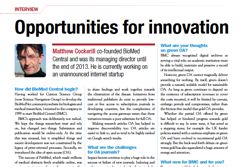Opportunities for innovation

Matthew Cockerill co-founded BioMed Central and was its managing director until the end of 2013. He is currently working on an unannounced internet startup
How did BioMed Central begin?
Having worked for Current Science Group (now Science Navigation Group) to develop the BioMedNet community website for biologists and medical researchers, I returned to the company in 1999 to start BioMed Central (BMC).
BMC’s approach was deliberately not radical. We kept the things researchers trust and rely on, but changed two things. Submission and publication would be online-only. At the time this was unusual, but it simplified things and meant development was not constrained by the legacy of print-oriented processes. Secondly, we introduced the idea of open access (OA).
The success of PubMed, which made millions of medical abstracts freely available online, was an important trigger for similar access to the published articles resulting from publicly-funded research. Harold Varmus (then head of the NIH) and David Lipman (head of the NCBI, which runs PubMed) were advocates for OA and helped to drive change by creating an infrastructure, in the form of PubMed Central, which encouraged and supported new OA publishers such as BMC.
A key challenge for launching new, online-only, OA journals is to ensure people can find the published research, and indexing in PubMed was critical for this. PubMed Central’s function as a permanent digital repository also helped answer the concern about what would happen if an OA publisher went out of business.
Why open access?
OA facilitates cross-fertilisation between fields, which is important with research becoming more interdisciplinary and translational. There is also a strong moral argument that patients should have access to the results of research they have funded as taxpayers, and may have contributed to directly as participants in clinical trials.
OA has also made a huge difference for researchers in the developing world. For example, BMC’s Malaria Journal acts as a platform for researchers in all countries and fields to share findings and work together towards the elimination of the disease. Initiatives from traditional publishers do exist to provide low-cost or free access to subscription journals in developing countries, but the complexities of navigating the access gateways mean that these initiatives remain a poor substitute for full OA.
Making research articles OA has helped to improve discoverability too. OA articles are easier to link to, and so tend to be highly ranked on Google search results.
What are the challenges for OA journals?
Impact factors continue to play a huge role in the success or failure of new journals. Indexing and archiving services have to decide what to include, and the profusion of poor-quality journals means that some form of selectivity is probably essential. But the current situation means that high-quality new journals can be stymied from the start, waiting many years for their first impact factor.
Having said that, by the end of 2013 more than 150 BMC journals had impact factors. This is one indication that, despite the challenges, the tide with respect to OA is only going in one direction.
The traditional subscription model is awkward from everybody’s perspective. With library budgets saturated by the costs of existing journals, subscribing to new ones often required others to be cancelled. One of the great things about OA is that the funding naturally scales with the amount of research being done. It is then just a matter of figuring out what percentage of funding needs to go towards paying for article processing charges.
What are your thoughts on green OA?
BMC always recognised digital archives as serving a vital role; an academic institution must be able to build, maintain and preserve a record of its intellectual output.
However, green OA cannot magically deliver something for nothing. By itself, green doesn’t provide a natural, scalable model for sustainable OA. As long as green continues to depend on the existence of subscription revenues to cover the costs incurred, it will be limited by caveats, embargo periods and compromises, rather than the friction-free model that gold OA provides.
Whether the partial OA offered by green has helped or hindered progress towards gold is difficult to say. In some ways, it has acted as a stepping stone; for example the UK funder policies started with a cautious emphasis on green OA and have evolved to recommend gold OA strongly. But the back-and-forth debate on green versus gold has also squandered a huge amount of energy and attention.
What now for BMC and for you?
Running an established, large-scale business is very different from being part of a start-up. There are always new areas where innovation is needed, but the same factors that make it natural for big companies to consolidate and standardise also reduce flexibility and tend to make in-house innovation difficult.
I very much enjoyed working at BMC as it developed, but there’s nothing like the initial phase of spotting new niches and then trying things out to see what fits.
One area where I see opportunities is the radical shift starting to happen in the relationship between patients and their health and clinical data. Patients today are demanding greater involvement in their care and more direct access to their medical data.
Meanwhile, the medical data itself is becoming more complex to manage. The use of genomic data in the clinic is going through massive expansion and the next wave of ‘wearable’ smart sensors will soon be collecting huge amounts of medically-relevant data. Building easy-to-use secure tools to help patients, clinicians and researchers deal with this health data explosion is going to be an interesting challenge.
Interview by Sian Harris






